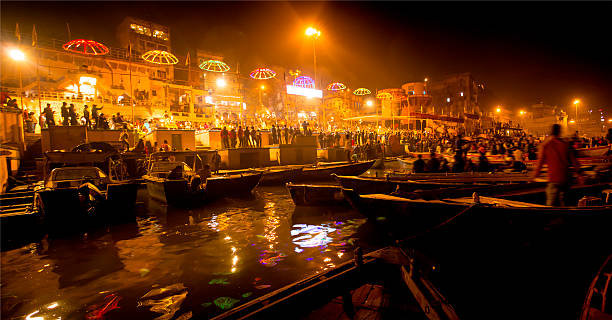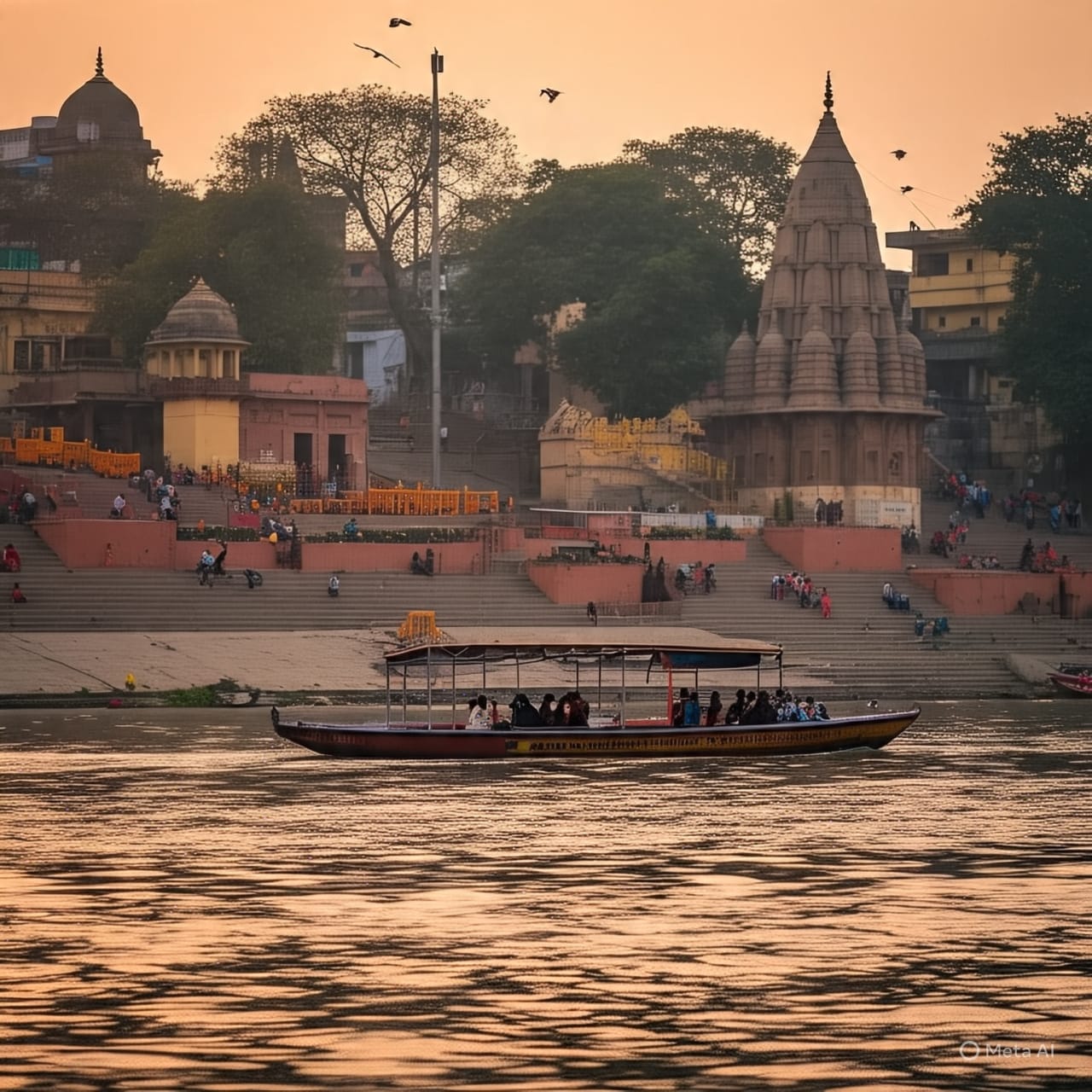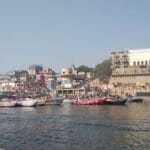Best Time to Visit Varanasi
Introduction – Planning Your Perfect Varanasi Trip
Choosing the right time to visit Varanasi can make the difference between a memorable spiritual journey and an uncomfortable struggle with extreme weather. This ancient city experiences three distinct seasons, each offering unique advantages and challenges for travelers. Understanding Varanasi’s climate patterns will help you pack appropriately, plan activities effectively, and make the most of your sacred journey to India’s spiritual capital.
Varanasi’s weather directly impacts your temple visits, ghat explorations, and overall travel experience. The city’s location in the Gangetic plains of North India subjects it to typical continental climate patterns with hot summers, monsoon rains, and pleasant winters. Let’s explore each month to help you choose your ideal travel window.
Best Time to Visit Varanasi

Overview of Varanasi’s Climate
Best Time to Visit Varanasi : Varanasi experiences a subtropical climate with three main seasons: winter (November to February), summer (March to June), and monsoon (July to October). The city’s proximity to the Ganges River provides some humidity moderation, but temperatures can still reach extremes during peak summer months.
The sacred ghats, narrow lanes, and crowded temples can feel particularly intense during hot weather, making season selection crucial for comfortable exploration. Religious festivals and pilgrim crowds also vary seasonally, affecting accommodation prices and availability.
Winter Season: The Golden Period (November – February)
November – The Perfect Beginning
Temperature: 12°C to 28°C (54°F to 82°F) Weather: Pleasant and comfortable Crowd Level: Moderate to High
Best Time to Visit Varanasi : November marks the beginning of Varanasi’s tourist season and for good reason. The oppressive summer heat has lifted, monsoon humidity has cleared, and temperatures settle into the perfect range for sightseeing. Morning boat rides become delightful experiences as the cool breeze off the Ganges provides natural air conditioning.
This month offers crystal-clear skies perfect for photography, especially during the golden hour at sunrise and sunset. The famous Ganga Aarti ceremonies feel more enjoyable without the distraction of sweat and discomfort. Temple visits become pleasant experiences rather than endurance tests.
What to Pack: Light cotton clothes for day, warm layers for early morning and evening, comfortable walking shoes, light jacket.
December – Peak Comfort Zone
Temperature: 8°C to 24°C (46°F to 75°F) Weather: Cool, dry, and extremely pleasant Crowd Level: High
Best Time to Visit Varanasi : December represents the sweet spot of Varanasi weather. Daytime temperatures remain comfortable for extensive walking, while evenings become cool enough to enjoy outdoor dining and riverside strolls. The low humidity makes even crowded temple visits bearable.
This month sees some of the year’s clearest skies, offering stunning sunrise views over the Ganges. The cool weather makes longer boat trips enjoyable, and exploring the old city’s narrow lanes becomes a pleasure rather than a chore. Hotel rates peak during this month due to high demand.
Festival Highlight: Various winter festivals and cultural events take advantage of the pleasant weather.
What to Pack: Warm clothes for morning and evening, light layers for afternoon, woolen shawl, comfortable shoes.
January – Winter’s Peak
Temperature: 5°C to 22°C (41°F to 72°F) Weather: Cold mornings and evenings, pleasant days Crowd Level: High
Best Time to Visit Varanasi : January brings Varanasi’s coolest temperatures, making it ideal for travelers who prefer cooler climates. Morning boat rides require warm clothing, but the crisp air provides excellent visibility for photography and sightseeing. The cool weather makes walking tours of the ghats particularly enjoyable.
Dense fog can occasionally reduce visibility during early morning hours, but this often creates mystical photographic opportunities. The contrast between cool mornings and warm afternoons allows for diverse activities throughout the day.
Festival Highlight: Makar Sankranti and various winter religious observances.
What to Pack: Heavy woolens for morning/evening, light cotton for afternoon, warm hat, gloves for very early morning activities.
February – Transitioning Warmth
Temperature: 8°C to 26°C (46°F to 79°F) Weather: Cool mornings, warm days, pleasant evenings Crowd Level: Moderate to High
Best Time to Visit Varanasi : February maintains the advantages of winter weather while gradually warming toward spring. This month offers perhaps the most balanced weather conditions – cool enough for comfortable daytime exploration yet warm enough to avoid heavy winter clothing.
The gradual temperature increase makes February perfect for travelers who want pleasant weather without winter’s cold mornings. Temple visits remain comfortable, and evening activities along the ghats continue to be enjoyable.
Festival Highlight: Maha Shivratri often falls in February, creating special spiritual atmosphere.
What to Pack: Light layers, warm clothes for early morning, cotton clothes for day, light jacket for evening.
Summer Season: The Challenging Period (March – June)
March – Pleasant Transition
Temperature: 12°C to 32°C (54°F to 90°F) Weather: Warm days, comfortable evenings Crowd Level: Moderate
Best Time to Visit Varanasi : March marks the beginning of Varanasi’s warming trend, but temperatures remain manageable for most activities. Early mornings continue to be pleasant for boat rides and temple visits, while afternoons become noticeably warmer. This month offers a good compromise between comfortable weather and smaller crowds.
Tourist numbers begin to decline as temperatures rise, potentially offering better accommodation rates and less crowded attractions. However, the weather remains acceptable for most travelers, especially those from cooler climates.
Festival Highlight: Holi celebrations bring vibrant colors to the city.
What to Pack: Light cotton clothes, sun hat, sunglasses, sunscreen, light jacket for morning.
April – Rising Heat
Temperature: 18°C to 38°C (64°F to 100°F) Weather: Hot days, warm evenings Crowd Level: Low to Moderate
Best Time to Visit Varanasi : April presents the first real challenge for Varanasi visitors as temperatures climb significantly. Midday temple visits become uncomfortable, making early morning and late evening the best times for sightseeing. The famous ghats can feel particularly hot due to stone surfaces absorbing and radiating heat.
Despite the challenges, April offers advantages including lower tourist crowds, better hotel rates, and more authentic interactions with locals. Early morning boat rides remain pleasant before the heat builds.
Strategy: Focus activities on early morning (5-9 AM) and late evening (6-9 PM).
What to Pack: Lightweight, light-colored cotton clothes, wide-brimmed hat, strong sunscreen, plenty of water.
May – Peak Summer Challenge
Temperature: 24°C to 42°C (75°F to 108°F) Weather: Very hot and dry Crowd Level: Low
Best Time to Visit Varanasi : May represents one of Varanasi’s most challenging months for tourism. Daytime temperatures regularly exceed 40°C (104°F), making outdoor activities extremely difficult. The stone ghats become too hot to walk on barefoot, and temple visits require careful timing.
However, dedicated travelers can still enjoy Varanasi in May by adjusting schedules dramatically. Very early morning activities (before 7 AM) and late evening events (after 7 PM) remain feasible. Air-conditioned accommodations become essential rather than luxurious.
Survival Tips: Stay hydrated, seek shade frequently, limit outdoor activities to early morning and late evening.
What to Pack: Minimal light cotton clothing, cooling towels, electrolyte supplements, strong sun protection.
June – Summer’s Peak
Temperature: 26°C to 44°C (79°F to 111°F) Weather: Extremely hot with occasional pre-monsoon showers Crowd Level: Very Low
June brings Varanasi’s highest temperatures along with pre-monsoon humidity that makes the heat feel even more intense. Most tourist activities become impractical during daylight hours. However, brave travelers can find unique experiences in this extreme season.
The very low tourist numbers mean you’ll have attractions largely to yourself, and hotel rates hit their annual minimum. Pre-monsoon thunderstorms provide dramatic skies and temporary relief from heat.
Only for: Heat-tolerant travelers or those with specific seasonal interests.
What to Pack: Absolute minimum light clothing, cooling accessories, indoor entertainment options.
Monsoon Season: The Dramatic Period (July – October)
July – Monsoon Arrival
Temperature: 24°C to 35°C (75°F to 95°F) Weather: Hot, humid with increasing rainfall Crowd Level: Low
July brings the arrival of monsoon rains, providing relief from summer’s extreme heat but introducing new challenges. The humidity increases significantly, and rainfall becomes frequent though often brief. The Ganges begins to swell, changing the entire riverside landscape.
This month offers unique photographic opportunities as the rain-washed ghats and temples take on new beauty. However, outdoor activities become unpredictable due to sudden downpours.
Unique Experience: Watching the Ganges transform with monsoon waters.
What to Pack: Waterproof clothing, umbrella, quick-dry clothes, waterproof bags for electronics.
August – Full Monsoon
Temperature: 24°C to 33°C (75°F to 91°F) Weather: Heavy rainfall, high humidity Crowd Level: Very Low
August typically sees Varanasi’s heaviest rainfall, with the Ganges at or near flood stage. The city takes on a completely different character as monsoon rains transform the ancient architecture and create dramatic atmospheric conditions.
While challenging for conventional tourism, August offers unparalleled opportunities to witness Varanasi’s resilience and natural beauty. The reduced crowds provide intimate experiences with the city’s spiritual life.
Photography Gold: Monsoon clouds, flooded ghats, rain-soaked ancient architecture.
What to Pack: Comprehensive rain gear, moisture-absorbing packets for cameras, anti-fungal foot powder.
September – Late Monsoon
Temperature: 23°C to 33°C (73°F to 91°F) Weather: Decreasing rainfall, high humidity Crowd Level: Low
September marks the gradual retreat of monsoon rains, though humidity remains high. The weather becomes more predictable, allowing for better trip planning while still maintaining monsoon season’s dramatic beauty.
The Ganges remains swollen, creating unique scenic opportunities. Tourist crowds stay low, providing authentic cultural experiences without the typical tourism infrastructure pressures.
Festival Season Begins: Preparation for major autumn festivals starts.
What to Pack: Mix of rain gear and regular clothes, humidity-appropriate fabrics, moisture-wicking materials.
October – Post-Monsoon Recovery
Temperature: 17°C to 32°C (63°F to 90°F) Weather: Decreasing humidity, occasional showers Crowd Level: Moderate
October represents the transition from monsoon to winter season. Humidity begins dropping, making outdoor activities more comfortable again. The post-monsoon landscape shows Varanasi at its most lush and green.
This month offers excellent value for travelers, with monsoon season prices but increasingly pleasant weather. The Ganges settles back to normal levels, restoring typical ghat activities.
Festival Highlight: Durga Puja and Dussehra celebrations bring cultural vibrancy.
What to Pack: Light layers, occasional rain protection, comfortable walking shoes that dry quickly.
Festival Calendar and Weather Impact
Major Festivals and Best Weather
Diwali (October/November): Perfect weather coincides with the Festival of Lights, creating magical evening celebrations along the ghats.
Maha Shivratri (February/March): Cool weather makes all-night temple vigils comfortable for devotees.
Holi (March): Pleasant temperatures allow for comfortable participation in color festivals.
Ganga Aarti: Daily ceremonies are most enjoyable during winter months when evening temperatures are comfortable for outdoor gatherings.
Month-by-Month Recommendations
Best Months (December – February)
- Ideal for: First-time visitors, photography enthusiasts, cultural tours
- Expect: Higher prices, crowded attractions, perfect weather
- Book: Accommodations well in advance
Good Months (October – November, March)
- Ideal for: Budget travelers, experienced India travelers
- Expect: Moderate crowds, reasonable prices, good weather
- Book: Standard advance booking sufficient
Challenging but Rewarding (April, September)
- Ideal for: Adventure travelers, those seeking authentic experiences
- Expect: Lower crowds, discounted rates, weather challenges
- Prepare: Flexible itineraries, appropriate gear
Expert Level Only (May – August)
- Ideal for: Heat/humidity tolerant travelers, monsoon enthusiasts
- Expect: Very low crowds, minimal prices, extreme conditions
- Required: Serious preparation and weather-appropriate expectations
Packing Essentials by Season
Winter Essentials
- Layered clothing system
- Warm jacket for early morning boat rides
- Comfortable walking shoes
- Light woolen accessories
Summer Survival Kit
- Lightest possible cotton clothing
- Industrial-strength sunscreen
- Cooling towels and sprays
- Electrolyte supplements
- Sun hat and sunglasses
Monsoon Gear
- Quality waterproof jacket and pants
- Quick-dry clothes
- Waterproof bags for electronics
- Anti-fungal foot care products
- Compact umbrella
Local Tips for Each Season
Winter Strategy
Start early to catch beautiful sunrise light, layer clothes for temperature variations throughout the day, book evening boat rides for comfortable Ganga Aarti viewing.
Summer Survival
Schedule all outdoor activities before 9 AM or after 6 PM, stay hydrated constantly, use cooling centers (temples, museums) during peak heat hours.
Monsoon Adaptation
Embrace the dramatic weather for unique photo opportunities, have indoor backup plans for rainy days, use local transport carefully on wet roads.
Conclusion: Choosing Your Perfect Time
The best time to visit Varanasi ultimately depends on your personal preferences, tolerance for weather extremes, and travel goals. December through February offers the most comfortable experience for first-time visitors, while shoulder seasons provide great value for experienced travelers.
If you’re seeking spiritual experiences, remember that Varanasi’s sacred energy transcends seasonal discomfort. Many pilgrims visit during challenging weather periods specifically to test their dedication and commitment.
For photography enthusiasts, each season offers unique opportunities – winter’s clear skies, summer’s dramatic heat haze, and monsoon’s moody atmosphere all create distinctive visual stories.
Budget travelers might find tremendous value in off-season visits, when accommodation costs drop significantly and you’ll have attractions largely to yourself. However, prepare thoroughly for weather challenges and potential service limitations during extreme seasons.
Whatever time you choose, Varanasi will provide an unforgettable experience. The city’s timeless spiritual energy, architectural wonders, and cultural richness shine through regardless of weather conditions. Plan appropriately for your chosen season, pack smart, and prepare for a journey that will touch your soul regardless of the temperature outside.





